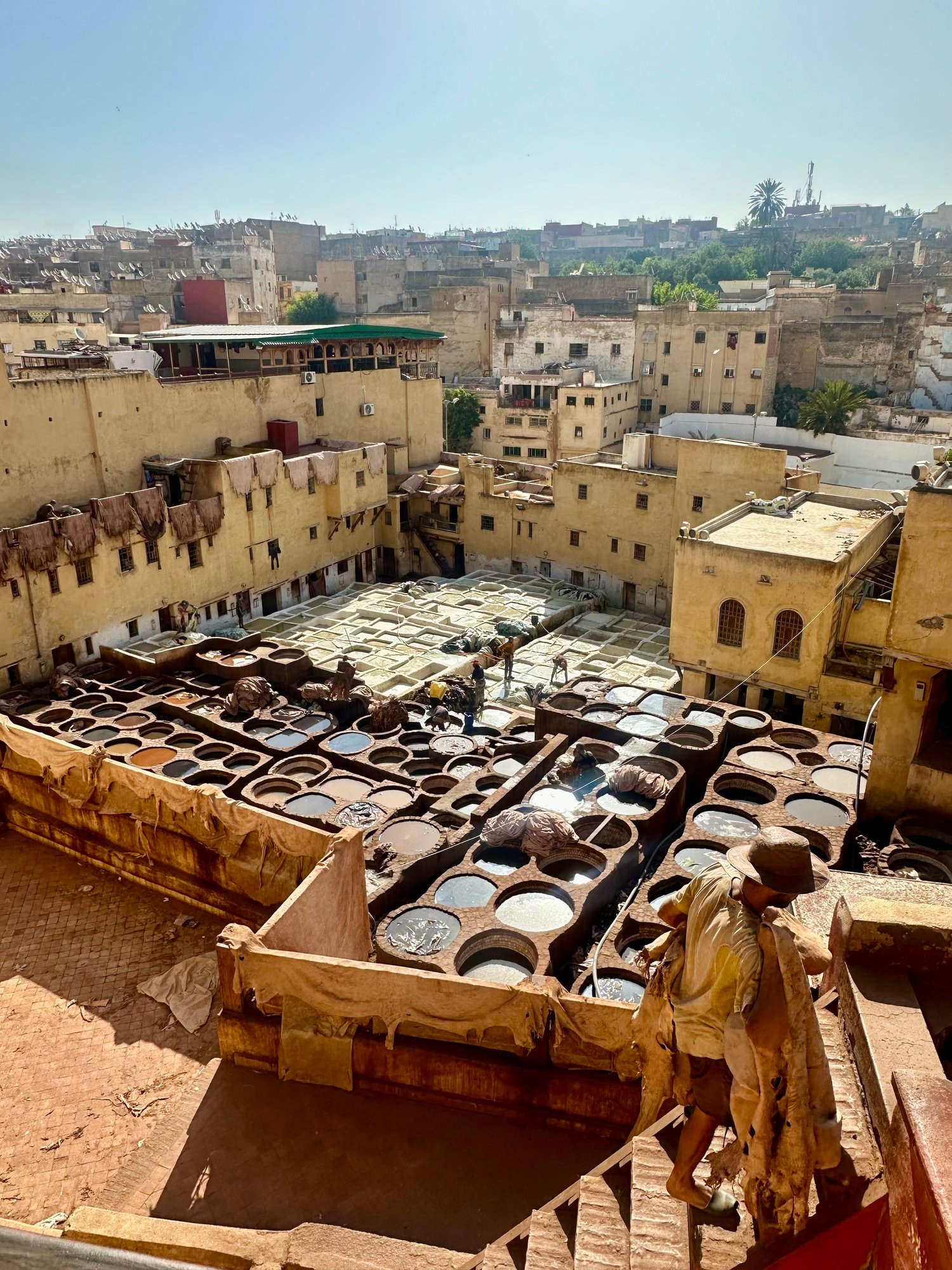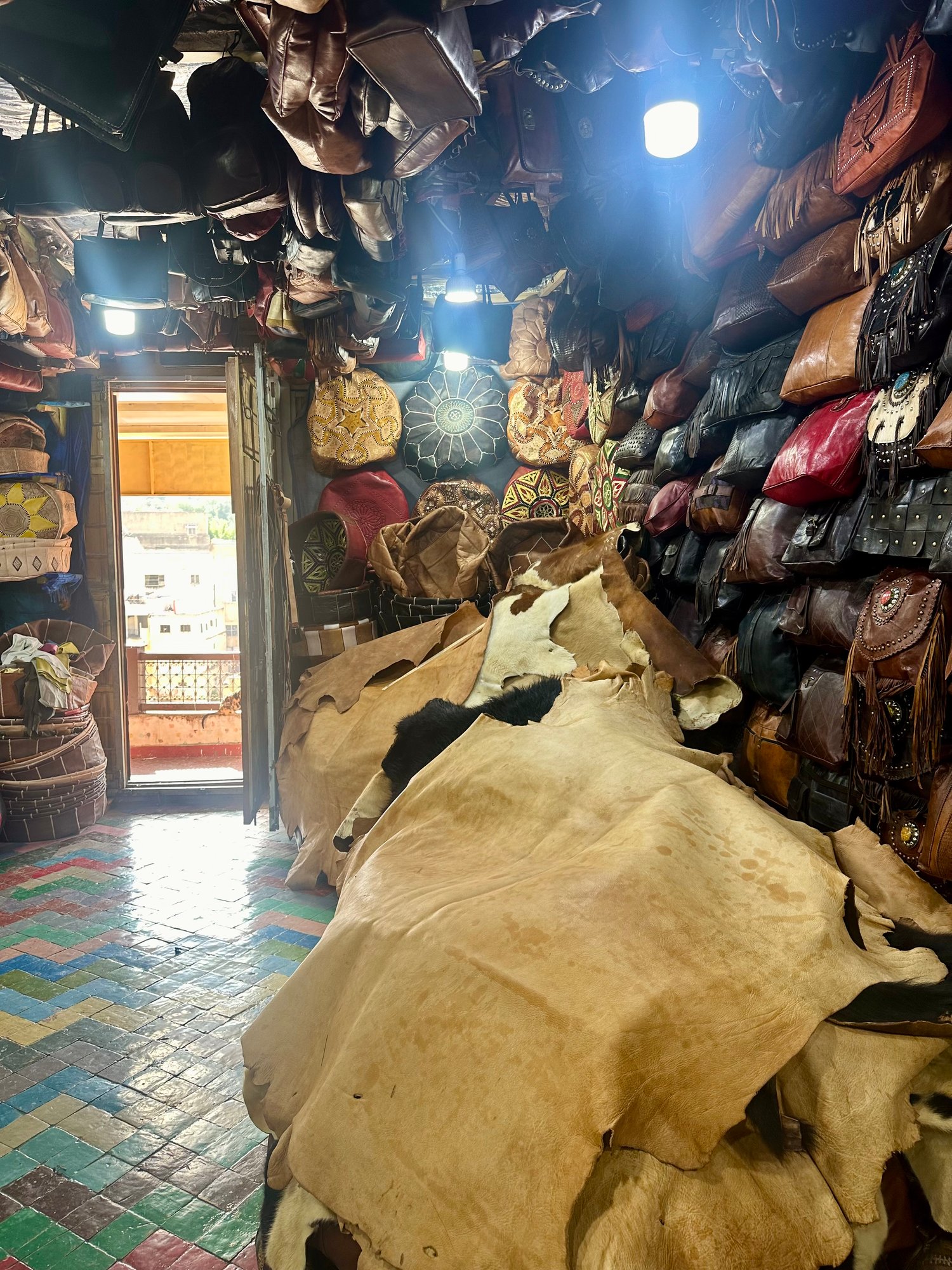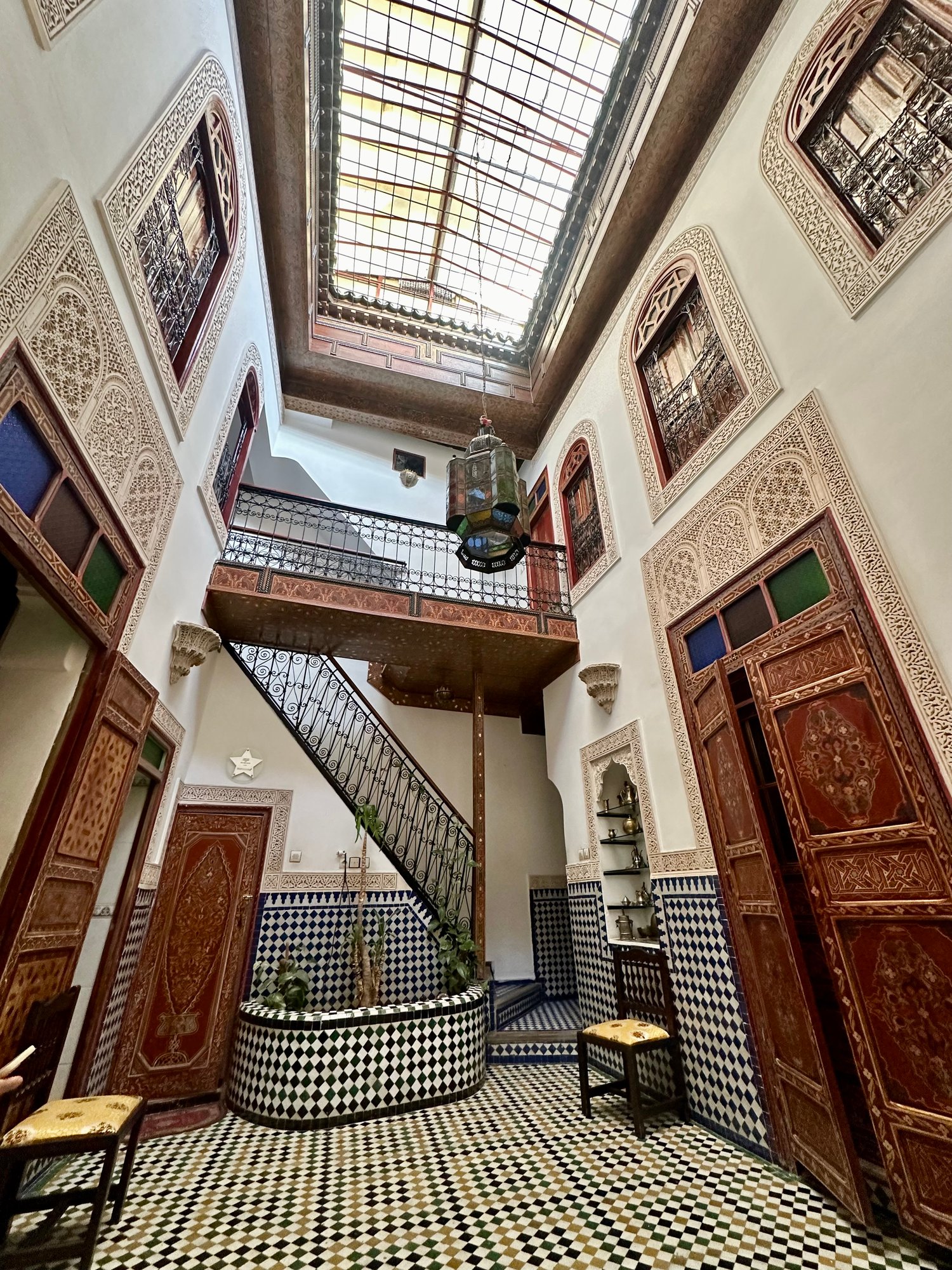Things You Should Know Before Visiting Fez
Before diving into our experience, here are a few key things that will help you navigate Fez a little more smoothly:
- Blue Gate (Bab Bou Jeloud) is the iconic entrance to the Old Medina and a crucial reference point. If you get lost (which is very likely), this is your compass.
- The bus and train stations are located in the new part of Fez, about a 40-minute walk from the Old Medina.
- From there, it’s best to take one of the red petit taxis, small, metered city taxis licensed to carry up to three passengers, that can drop you right by the Blue Gate.
- Fez is divided into two main areas: the new city, with wide boulevards and modern resorts like the 5-star Marriott, and Fez el-Bali, the ancient, car-free Old Medina, one of the only medinas of its kind in the world.
- The Old Medina is HUGE, and it's famously described as a labyrinth—and it truly is. Be prepared for narrow, dim alleyways, sensory overload, and getting lost (probably more than once). Locals don’t know exactly how many alleys there are, but it’s estimated that there are well over 9,000!
- Talaa Seghira and Talaa Kebira are the two main streets within the medina. They're slightly wider and busier than the rest of the alleys and are lined with shops and restaurants. Knowing where these streets are can help you stay oriented.
- There are three main tanneries in Fez, but the most famous, oldest, and largest is Chouara Tannery, that’s the one you want to visit.
- Tip: To avoid the chaos and confusion, book a guided walking tour. For less than €15, you’ll get a 3-hour tour with a local guide who will help you understand the culture and navigate the maze.
Our Experience in Fez
We arrived in Fez on a warm afternoon and stayed for two nights, basing ourselves at Dar Hafsa, a traditional Moroccan house located just steps away from the Old Medina. The hospitality was incredible, and our host was key in helping us plan our visit to the Chouara Tannery, which was our top priority while in Fez.
We dedicated one day to exploring Fez and spent the other on a day trip to Chefchaouen, the magical blue city. Let me tell you, Fez is not for the faint-hearted. It completely overwhelmed and fascinated me in equal measure.
Navigating the Old Medina is a serious challenge. Even though we successfully made it to the Chouara Tannery (thanks again to our host), trying to find our way back on our own was a disaster. Within minutes, we were completely lost.
The medina’s maze-like alleys are dark, tight, and disorienting. Add in the constant sounds of metalwork, the smell of leather and spices (and yes, sometimes garbage), and it becomes a full-blown sensory overload. Garbage is collected by a man with a donkey cart, which was a surreal sight for us coming from Europe, but also an eye-opener to how different life is here!
As we wandered through the medina, locals frequently offered to guide us, some even followed us despite our polite refusals. One young boy stuck with us for a while and later demanded 100 MAD each (around €10) for his “help.” A word of warning: if someone tells you a street is closed or that it doesn’t lead anywhere, it’s likely not true. Our host at Dar Hafsa emphasized this clearly, only trust your guide or your accommodation host, and he repeated that advice more than once. This kind of persistence felt unique to Fez; we never experienced anything like it in Marrakech. Again, a guided tour would’ve saved us a lot of stress and will help you avoid unpleasant encounters (especially if you're a female solo traveler). Don’t make the same mistake, get a local guide.
There’s a common misconception that Google Maps doesn’t work in Fez—but that’s not entirely true. The issue is that the medina is made up of a maze of tiny alleyways, many of which lead directly into people’s homes and aren’t fully mapped. So while Google Maps can give you a general direction, you’ll likely find that it loses track of your exact location once you're deep inside the medina.
Tip: After hearing mixed reviews about Airalo not working well in Morocco, we opted for a Revolut eSIM, and it worked perfectly across all cities during our 9-day trip.
Visiting the Chouara Tannery
The Chouara Tannery is unlike anything I’ve ever seen, raw, ancient, intense, and fascinating. It’s absolutely worth the effort to get there, but beware: many locals will try to lure you to other, smaller tanneries, falsely claiming it’s Chouara.
The smell is intense, no doubt about it. Locals will offer you mint sprigs to hold under your nose to mask the odor. But before you flinch or complain in disgust, consider this: the workers here spend their days waist-deep in vats of dye, pigeon poop, and other natural substances to produce some of the finest leather goods in the world. It’s a tradition passed down for centuries and deserves both admiration and respect, not just photos.
Fun fact: The leather is tanned in stone vats using a 1,000-year-old process. Pigeon droppings and cow urine are used to soften the hides before dyeing. It’s an ancient method that might sound unpleasant, but it’s still used today.

Tannery Tips & Ethics
Surrounding the tannery are dozens of leather shops selling bags, shoes, jackets, and poufs. Many of these shops have rooftops or balconies where you can get a great view of the dye pits. But be cautious, some shopkeepers may pressure you into making a purchase after the viewing. To avoid this, make it clear up front that you’re only interested in the view.
It’s customary to tip around 10 MAD per person for the viewing experience. Do not accept help from any of the boys lingering outside, they will demand payment and can be aggressive.
If you’re going solo, I recommend visiting shop #10 for the best vantage point of the tannery, look for the black sign marked with the number 10 on Derb Chouara (derb refers to a dead end street). The owner was genuinely kind, showed us both viewing terraces, gave us mint sprigs, and didn’t pressure us to buy anything.

Final Tips & Thoughts
- Dress appropriately: For women especially, dressing conservatively is recommended. While tourists are technically free to wear what they like, we found that in Fez, revealing clothing can attract unwanted attention, more so than in other parts of Morocco. Modest clothing will help you feel more comfortable and respected.
- Currency and costs: Most established shops and restaurants accept credit cards, but street vendors, taxi drivers, and smaller markets typically do not. Make sure to carry local currency (MAD) with you. Euros are also widely accepted in tourist areas.
- Learn to haggle: Bargaining is a way of life in Morocco, especially in the souks. A local guide told us, "If you don’t haggle, you’re doing it wrong." Negotiating prices is expected and it can save you quite a bit of money.
- Spoken languages: Most Moroccans speak a blend of Arabic, French, and English. English is generally understood in tourist areas, but learning a few basic phrases in Arabic goes a long way.
- Salam Alaykum – Hello
- Shukran – Thank you
- La shukran – No thank you (you’ll use this one a lot)
Fez challenged me, educated me, and humbled me. It’s chaotic, complex, intense and absolutely steeped in history. It may not be the easiest city to navigate, but it’s one that will leave a lasting impact. Prepare to get lost but also, prepare to be changed.
Happy Travels! x
For more travel inspiration, don’t forget to follow me on Instagram @journeywithme.mt
Disclaimer: All content and photos in this blog post are my own unless otherwise stated. Please do not copy, reproduce, or use any images or text without written permission.
Affiliate Disclosure:
This post contains an affiliate link. If you make a purchase through it, I earn a small commission at no extra cost to you. Thank you for your support!

